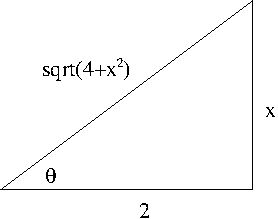What is a differential equation?
A differential equation is an equation that connects the unknown function $y=y(x)$ and its derivatives $$F(x,y,y’,y^{\prime\prime},\cdots)=0$$ where $F$ is a known function. The order of a differential equation is the order of the highest derivative which appears in the equation.
A first-order differential equation is an equation of the form $$F(x,y,y’)=0$$ or $$y’=f(x,y)$$ The simplest case would be $$y’=f(x)$$ in which case the solution is given by $$y=\int f(x)dx$$ Suppose now that $f(x,y)$ is separable, namely $$f(x,y)=g(x)h(y)$$ $\frac{dy}{dx}=g(x)h(y)$ is called a differential equation with variable separable.
Example. Solve $\frac{dy}{dx}=xy$.
Solution. The equation can be written as \begin{equation}\label{eq:sepeq}\frac{dy}{y}=xdx\end{equation} Integrating \eqref{eq:sepeq} i.e. $$\int\frac{dy}{y}=\int xdx$$ we obtain $$\ln y=\frac{x^2}{2}+C’$$ where $C’$ is a constant. Hence the solution is $y$ is given by \begin{align*}y&=e^{\frac{x^2}{2}+C’}\\&=e^{C’}e^{\frac{x^2}{2}}\\&=Ce^{\frac{x^2}{2}}\end{align*} where $C=e^{C’}$.
The solution of a first-order differential equation comes with an undetermined constant. Such a constant can be determined by a so-called initial condition $y(x_0)=y_0$.
Example. Find the solution of $$\frac{x}{1+x^2}dx-\frac{y^2}{1+y^3}dy=0$$ with the initial condition $y(0)=1$.
Solution. \begin{align*}\int\frac{x}{1+x^2}dx-\int\frac{y^2}{1+y^3}dy=0&\Longrightarrow \frac{1}{2}\ln(1+x^2)-\frac{1}{3}\ln(1+y^3)=\frac{1}{6}\ln C\\&\Longrightarrow\frac{(1+x^2)^3}{(1+y
^3)^2}=C\end{align*} where $C$ is a constant. For $x=0$ and $y=1$, $C=\frac{1}{4}$. Therefore the solution is $$(1+y^3)^2-4(1+x^2)^3=0$$
One of the reasons we study differential equations is that many natural phenomena are modeled by differential equations. These models not only tell you what is going on with the natural phenomena but also can predict what is going to happen with the phenomena in the future. We discuss some examples of simple such modelings by differential equations.
Example. A bullet with speed $v_0=400$m/s travels through a wall of thickness $h=20$cm. When the bullet comes out of the wall, its speed is $v_1=100$m/s. If the wall’s resistance is proportional to $v^2$, the square of speed, how long does the bullet travel inside the wall?
Solution. By Newton’s second law of motion the resistance is $$m\frac{dv}{dt}=-kv^2$$ which can be written as $$\frac{dv}{v^2}=-\frac{k}{m}dt$$ Set $k_1=\frac{k}{m}$ and integrate. $$\int\frac{dv}{v^2}=-\int k_1dt$$ and it results in \begin{equation}\label{eq:bullet}\frac{1}{v}=k_1t+C\end{equation} where $C$ is a constant. If $v(0)=v_0$ then $C=\frac{1}{v_0}$. If $v(T)=v_1$ then \begin{equation}\label{eq:bullet2}\frac{1}{v_1}=k_1T+\frac{1}{v_0}\end{equation} Solving \eqref{eq:bullet2} for $T$, $$T=\frac{1}{k_1}\left(\frac{1}{v_1}-\frac{1}{v_0}\right)$$ \eqref{eq:bullet} can be written as $$\frac{1}{v}=\frac{k_1v_0t+1}{v_0}$$ which can then be written as the differential equation $$\frac{dx}{dt}=\frac{v_0}{k_1v_0t+1}$$ By the integral $$\int dx=\int\frac{v_0}{k_1v_0t+1}dt$$ we find $$x(t)=\frac{1}{k_1}\ln(k_1v_0t+1)+C_1$$ where $C_1$ is a constant. Since $x(0)=0$, $C_1=0$. $x(T)=h$ results in \begin{equation}\label{eq:wall}h=\frac{1}{k_1}\ln(k_1v_0T+1)\end{equation} Solving \eqref{eq:wall} the bullet’s traveling time $T$ within the wall is $$T=\frac{h}{\ln\left(\frac{v_0}{v_1}\right)}\left(\frac{1}{v_1}-\frac{1}{v_0}\right)$$ With $h=20$cm=0.2m, $v_0=400$m/s, and $v_1=100$m/s, we obtain $T=0.00108$ seconds.
Example. Boyle’s gas law is $$\frac{dV}{dP}=-\frac{V}{P}$$ for the volume $V$ of a fixed quantity of gas at pressure $P$ (and constant temperature). The integral $$\int\frac{dV}{V}=-\int\frac{dP}{P}$$ results in $$PV=k$$ where $k$ is a constant.
Example. [Radioactive Decay] The Basic Law of Radioactive Decay: The ratio of the number of atoms disintegrated in unit time to the total number of atoms is a constant that depends only on the species of atom. This ratio is called the probability of disintegration. Denote by $N(t)$ the quantity of atoms that have not disintegrated by time $t$. Then we have the differential equation $$\frac{dN}{dt}=-\lambda N$$ Here $\lambda$ is the probability disintegration. With the initial condition $N(t_0)=N_0$, the solution is given by $$N(t)=N_0e^{-\lambda t}$$ Radioactive atoms are characterized by their half-life $T$. Haf-life is the time during which the number of atoms $N$ reduces by half the original amount via disintegration. \begin{align*}\frac{N_0}{2}&=N_0e^{-\lambda T}\\T&=\frac{\ln 2}{\lambda}\approx\frac{0.693}{\lambda}\end{align*} There is another important quantity that characterizes radioactive atoms. It is
The mean lifetime $\tau$
Suppose that when an radioactive element was created ($t=0$), there were $N_0$ atoms. During the time interval $[t,t+dt]$ the quantity of atoms that disintegrated is approximately $$-dN=\lambda Ndt$$ All the atoms in this group lived roughly the same lifetime $t$. Among the atoms taken at $t=0$, there are groups of atoms that will have different lifetimes. The mean lifetime $\tau$ is given by $$\tau=\frac{\int_0^\infty t\lambda Ndt}{\int_0^\infty\lambda Ndt}=\frac{1}{\lambda}$$ i.e. the mean lifetime is exactly the inverse of the disintegration probability. $N(t)$ can be also written in terms of $\tau$ as $$N(t)=N_0e^{-\frac{t}{\tau}}$$ Half-life and mean lifetime are related by $$\tau=\frac{T}{\ln 2}\approx 1.443T$$ Radium has a half-life of 1,600 years. Thus \begin{align*}N&=N_0e^{-\frac{\ln 2}{1600}t}\\&=N_0e^{-0.00043t}\end{align*} For $t=200$, $$N(200)=N_0e^{-0.00043\times 200}\approx 0.918N_0$$ This means about 8.2% of the original amount of radium will be disintegrated in 200 years.
Example. [Lanchaster’s Law] Suppose that two armies, Red and Blue are engaging each other in combat. Red is shooting a continuous stream of bullets at Blue. Likewise Blue is shooting a continuous stream of bullets at Red. Assume that the rate of attrition depends only on the number of weapons shooting. Let $A$ represent the number of soldiers in the Red and $B$ represent the number of soldiers in the Blue army. Then we have the coupled system of differential equations \begin{align}\label{eq:lanchaster}\frac{dA}{dt}&=-\beta B\\\label{eq:lanchaster2}\frac{dB}{dt}&=-\alpha A\end{align} The constants $\alpha$ and $\beta$ are called offensive firepower of $A$ and $B$, respectively. Now divide \eqref{eq:lanchaster} by \eqref{eq:lanchaster2}. \begin{align*}\frac{dA}{dB}&=\frac{\beta}{\alpha}\frac{B}{A}\\&=E\frac{B}{A}\ (E=\frac{\beta}{\alpha})\end{align*} By the integral $$\int AdA=E\int BdB$$ we obtain $$A^2=EB^2+C$$ where $C$ is a constant. Suppose that $\alpha=\beta$ i.e. $E=1$ which means the Red and the Blue have the same firepower. Let $A(0)=100$ and $B(0)=50$. Then $C=7500$. If $B=0$, then $A=\sqrt{7500}\approx 86.6$. This means that if all soldiers in the Blue army get killed, the Red army would sustain the casualties of 13 deaths and 1 severely injured.

